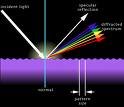I don't have the exact definition at hand, but you can find it in ANSI B46.1 - Surface Texture. Available from the American Society of Mechanical Engineers in New York. Waviness is a 'larger' feature than roughness. Roughness may be considered to be superimposed on a wavy surface.
One reference I have says - Waviness includes all irregularities whose spacing is greater than the roughness sampling length and less than the waviness sampling length.
This is correct. When you measure the vertical position of a stylus translated across a surface, you see a complex graph with many possible kinds of up and down bump patterns. One way used to analyse these graphs is to make a frequency profile, using Foreir transformations, recording the frequency of the height variations and the intensity. Thus different wavelenghts may be enhanced on some samples, indicating some periodicity from a certian sized machint tool.
Don't text gives the realtive length scales for the variations named. In the literature specific recriprocal micron numbers are used.

1 comment:
I have worked on a similar project in my undergraduate course. I now finished my masters in mechanical engineering from the university of sheffield. There are primarily two factors you would like to consider when analysing surface profiles of a machined component. Skewness and ketosis.
Post a Comment